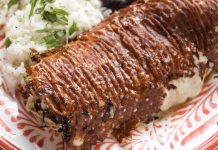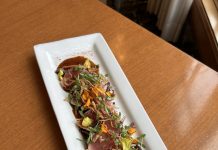
When the 72-year-old acclaimed Japanese film director Kitano Takeshi was once asked to give advice to young filmmakers, he encouraged the artists to be transgressive and to create characters who defy conventional notions of what a hero can and should be. “You can be delinquent, you don’t have to be a goodie goodie,” Takeshi said. In other words, stories don’t need more villains. Instead, they need antiheroes.
The relatively new Japanese-influenced restaurant on Nine Mile in downtown Ferndale called Antihero takes its ethos — and its name — from the idea that being a bit off-kilter beats being plain. When I first visited Antihero, and entered through its massive wooden doors, I kept wondering if I had stepped into an animated music video for the British band Gorillaz. The owners, who also run nearby spots Imperial and Public House, spent $1.5 million on the buildout and it shows. Spanning the entire length of the back wall is a breathtaking mural by Detroit-based artist Glenn Barr, which depicts a Tokyo meets Detroit meets Blade Runner scene. Above the bar are light fixtures that look like illuminated sea urchins suspended from the ceiling and along the perimeter are deep cutouts of sleek wooden booths that evoke the mood of a high-end sauna. And the bathrooms, hand painted by Shaina Kasztelan and Kadee Spangler, feature, among other things, a brightly colored deranged tiger holding a cupcake in one hand and an ice cream in the other that will make even the most cynical person smile.
Décor is such a tough thing to pull off, especially if you are cooking from a culture not of your own. Too often it is hammed up or worse, Orientalist. Antihero strikes a perfect balance in creating a space that’s warm, welcoming, and Instagram-friendly. The owner, Sharon LaVoinse, appropriately calls it “an inauthentically authentic space.”
Given how gorgeous the space is, some owners might rest on those laurels and forgo good service, but that was not my experience at Antihero. Our waitress graciously seated me and my friend only moments after we arrived and accommodated my admittedly pesky request to try a few different seats in the house so I could find the best view of Barr’s mural (my advice: the high-top tables near the bar).
I began with their most popular cocktail, the Tokyo S.O.S, which is served in a white, cat-shaped ceramic mug and consumed with a straw. It is made with bumba rum, vida mezcal, pineapple, lime, coconut, and Jarritos guava soda. I enjoyed it but since moving to Michigan, the cold weather has made me gravitate towards boozier drinks that give me a sucker punch and remind me that yes, I am still alive despite my first winter here. Soon after, our waitress was kind enough to switch my cocktail free of charge for her personal favorite — the Toki Ball which had a perfect blend of Suntory whiskey, carbonated water, and lemon, and is made using a Japanese machine that gives the drink more bubbles than champagne.
My friend and I then moved on to the Old Bay shrimp chips with grilled lemon and celery, as well as the black garlic chickpea fritter with yuzu whip, shiso, and chilli. The latter was the real standout, and this is where Antihero excels: the head chef Nick Erven takes something you might have tried lots of times, like garlic, and finds ways to make it new again to your palate. As Erven told me, “Dinner should be fun. The food here doesn’t try too hard.”
It is this playfulness in their approach that makes their food so enjoyable. Their pork buns, for example, served with pineapple barbecue, pickle, and butter lettuce are deservedly praised as my friend couldn’t stop talking about how delicious the pickles were. Other highlights include their salmon poke bowl, garnished with a delightful amount of citrus, and their wagyu beef strips, which made me wish all butter was mixed with miso sauce.
But the real surprise of the night was that Antihero somehow made me — the world’s biggest tofu skeptic — a fan of tofu. The culprit was their “chicken-fried” tofu, which is topped with mayo, soy-maple caramel, jalapeño, furikake, and cilantro. What exactly is soy-maple caramel and how do you make it? Actually, I believe the proper question is: Why isn’t this sauce drizzled on everything in life?
All the dishes were plated beautifully and if I weren’t so self-conscious about being around such an attractive and hip crowd, then yes, I would have licked the plate on a few items — especially the “chicken-fried” tofu.
We finished the meal with mochi doughnuts and stayed for a while, even after we finished everything on our table. In Japan, these types of restaurants are known as izakayas, a sort of informal Japanese pub that comes from the Japanese words “i” (to stay) and “sakaya” (a sake shop). The idea is that an izakaya is a place to linger, to share small plates, and most critically, to lose track of time.
Indeed, I had already paid the bill and thanked our waitress, but when I looked at my friend, he gave me a knowing nod. He did not want to leave, either.
Antihero, 231 W. Nine Mile Road., Ferndale; 248-307-7383. Sun.–Tues., 4-11p.m., Wed. & Thurs., 4 p.m.-12a.m., Fri. & Sat., 4 p.m.-2a.m.
Asian-American History
It was not that far from Antihero that Vincent Chin was murdered in an anti-Asian
attack in Highland Park in 1982. Two white autoworkers who had been laid off, accosted Chin, seemingly mistaking him as Japanese and blaming him for Japanese exports that were threatening U.S. jobs. Neither man served prison time, but did pay fines and were put on probation.
The event inspired Asian-Americans in metro Detroit, and indeed all over America, to form a more united Asian-American identity. They held regular meetings at the Golden Star Restaurant — now Post Bar — in Ferndale and in 2010, as result of their tireless activism, the city
of Ferndale unveiled a plaque on Woodward and Nine Mile Road to honor Chin’s memory.
Today, there are thriving Japanese communities all over Michigan. In Novi, around 16 percent of its 55,000 residents are of Asian origin and a $50-million “Asian Village” shopping complex will open there soon with the city’s blessing.
These days, a new Japanese restaurant, or family moving next door, doesn’t make news headlines for the wrong reasons, and this is progress all Michigan residents can feel proud about and celebrate.
|
|
|




















